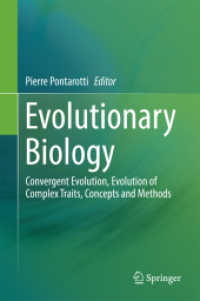- ホーム
- > 洋書
- > ドイツ書
- > Humanities, Arts & Music
- > History
- > miscellaneous
Description
(Text)
Der Lienzo Seler II (Coixtlahuaca II) aus der Sammlung des Ethnologischen Museums in Berlin ist eines der beeindruckendsten Objekte, die im Humboldt-Forum in Berlin präsentiert werden. Mixtekische und Chocho-Autoren stellten das große 383 cm x 442 cm große Baumwolltuch im 16. Jahrhundert im Tal von Coixtlahuaca (Oaxaca, Mexiko) her, um darauf den Ursprung ihrer Herrscher und die Gründung ihrer Siedlungen in dem multiethnischen Tal zu dokumentieren. Sie hielten Ereignisse fest, die eine Periode von mehr als 500 Jahren bis in die frühe spanische Kolonialzeit umfassen und ihren Anspruch auf Macht, Land und Privilegien im Stil der vorspanischen Bilderschrift sichtbar machen. Das Dokument ist nach seinem Sammler Eduard Seler benannt, der es 1897 nach Berlin brachte. Erstmalig wird der Lienzo in allen Details in zahlreichen Abbildungen farbig publiziert und von zehn internationalen Experten umfänglich nach neuesten Erkenntnissen interpretiert.
(Text)
Lienzo Seler II or Coixtlahuaca II is a complex pictographic document on cotton cloth measuring 383 by 442 cm. It was produced during the sixteenth century in the Northern Mixteca region in the Mexican state of Oaxaca. In her introduction (I), Elizabeth Hill Boone introduces the document: "Some decades after the Spanish conquest of Mexico and at a time when colonial rule was continuing to spread throughout the land, an indigenous lord of the city of Coixtlahuaca in Southern Mexico commissioned a large and visually stunning pictorial history. Its purpose was to recount the deep past of his noble lineage, demonstrate a long and unbroken continuity of rule, and define Coixtlahuaca's territory in the present with an eye toward the future. By retelling the story of past greatness, the history would validate the ruler's political rights and reaffirm control of ancestral lands." The Mixtec-Chocho speaking native painter-scribes of the Lienzo Seler II depicted changing perceptions of space in Mesoamerica in the transition from the pre-Hispanic to the colonial eras by using a new map-format but maintaining the ancient tradition of symbols. The events shown on the Lienzo cover a period of more than 500 years. The German scholar Eduard Seler acquired it in 1897 from the Mexican historian Manuel Martínez Gracida. Since then it has been housed in the Ethnologisches Museum in Berlin, Germany. The Lienzo recently underwent extensive physical analysis and a systematic photographic survey resulting in the images shown in the first section of the volume followed by eleven essays written by a group of international scholars that explore the document from different perspectives: its physical appearance and biography (II), its collectors (III), the subject themes and statements shown on the Lienzo, such as 'Space and Place' (IV), 'The Sacred Land' (V), and 'The Elite's Legacy' (VI). Contributions by Elizabeth Hill Boone, Bas van Doesburg, Maria Gaida, Viola König, Stephen A. Kowalewski, Silvia Marten, Mónica Pacheco Silva, John M. D. Pohl, Ina Reiche, Carlos Rincón Mautner, Araceli Rojas Martínez Gracida.




![コロコロクリリンぬりえワールド [ぬりえ]](../images/goods/ar2/web/imgdata2/43870/4387000627.jpg)



